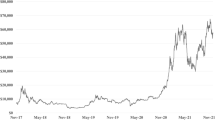Abstract
Bank regulation has undergone almost a complete circle from the Glass-Steagall Act (GSA, 1933), through a period of deregulation since 1980s, culminating in the repeal of GSA by the Gramm-Leach-Bliley Act (GLBA, 1999), to the Dodd-Frank Wall Street Reform and Consumer Protection Act (DFA, 2010), which attempted to restore some of the rules under GSA. The GLBA allowed the largest U.S. bank holding companies to expand into more market-sensitive business activities, which contributed to a significant increase in their market, operating and accounting risks. Despite increasing reporting requirements, bank accounting information decreased in value relevance in terms of both earnings quality and Statistical Cost Relationship during the post-GLBA period. The increasing opaqueness in the bank accounting information weakened market efficiency and had a negative impact on the effectiveness of regulatory supervision. Lessons learned from the repeal of GSA are timely and relevant to the implementation of DFA.
Similar content being viewed by others
References
Agostino M, Drago D, Silipo DB (2011) The value relevance of IFRS in the European banking industry. Rev Quant Finance Account 36:437–457
Akhavein JD, Berger AN, Humphrey DB (1997) The effect of bank megamerger on efficiency and prices: evidence from profit functions. Rev Ind Organ 12:95–139
Anandarajan A, Francis B, Hasan I, John K (2011) Value relevance of banks: global evidence. Rev Quant Finance Account 36:33–55
Barth ME, Hodder LD, Stubben SR (2008) Fair value accounting for liabilities and own credit risk. Account Rev 83:629–664
Basel Committee Comments on the IASB Exposure Draft of Proposed (2004). Amendments to IAS 39, financial instruments: recognition and measurement-the fair value option
Benston GJ, Wall LD (2005) How should banks account for loan losses. J Account Public Policy 24:81–100
Berger AN, DeYoung R (2001) The effect of geographic expansion on bank efficiency. J Financial Serv Res 19:163–184
Chow GC (1960) Test of equality between sets of coefficient in two linear regressions. Econometrica 28:591–605
Demsetz RS, Strahan PE (1997) Diversification, size and risks at bank holding companies. J Money Credit Bank 29:300–313
Eccher EA, Ramesh K, Thiagarajan RS (1996) Fair value disclosure by bank holding companies. J Account Econ 22:79–117
Hirst DE, Hopkins PE, Waklen JM (2004) Fair value, income measurement, and bank analysts’ risk and valuation judgments. Account Rev 79:453–472
Hodder LD, Hopkins PE, Wahlen JM (2006) Risk relevance of fair-value income measures for commercial banks. Account Rev 81:337–375
Jaggi B, Zhao R (2002) Information content of earnings and earnings components of commercial banks: impact of SFAS No. 115. Rev Quant Finance Account 18:405–421
Khurana IK, Kim M (2003) Relative value relevance of historical cost vs. fair value: evidence from bank holding companies. J Account Public Policy 22:19–42
Nelson KK (1996) Fair value accounting for commercial banks: an empirical analysis of SFAS No. 107. Account Rev 71:161–182
Niswander F, Swanson EP (2000) Loans, security, and dividend choices by individual (unconditional) public and private commercial banks. J Account Public Policy 19:201–235
Rose JT, Wolken JD (1986) Statistical cost accounting models in banking: a reexamination and an application. Board of Governors of the Federal Reserve System, Staff Study 150
Seow GS, Tam K (2002) The usefulness of derivatives-related accounting disclosure. Rev Quant Finance Account 18:273–291
Tadesse S (2006) The economic value of regulated disclosure: evidence from the banking sector. J Account Public Policy 25:32–70
Wang L, Alam P, Maker S (2005) The value relevance of derivative disclosures by commercial banks: a comprehensive study of information content under SFAS Nos. 119 and 133. Rev Quant Finance Account 25:413–427
Zhao R, He Y (2004) The impact of SFAS No. 114 on the linear information dynamics for commercial banks. Rev Quant Finance Account 23:313–328
Acknowledgments
The authors would like to acknowledge the insightful comments and helpful suggestions of the Editor, Cheng-Few Lee, and an anonymous reviewer. The usual disclaimer applies.
Author information
Authors and Affiliations
Corresponding author
Rights and permissions
About this article
Cite this article
Zhao, R., He, Y. The accounting implication of banking deregulation: an event study of Gramm-Leach-Bliley Act (1999). Rev Quant Finan Acc 42, 449–468 (2014). https://doi.org/10.1007/s11156-013-0349-9
Published:
Issue Date:
DOI: https://doi.org/10.1007/s11156-013-0349-9




